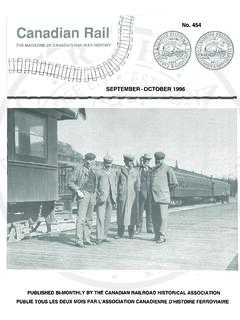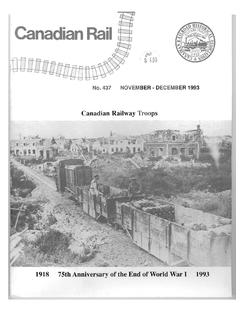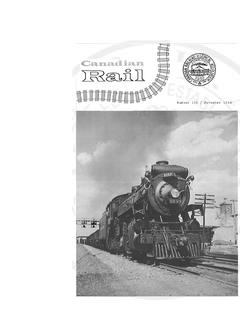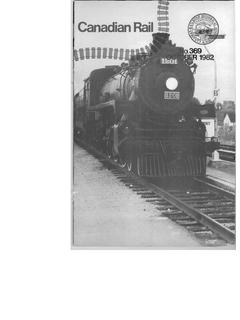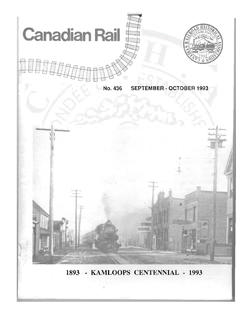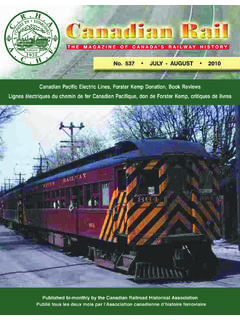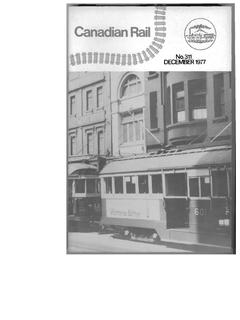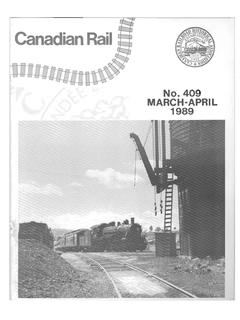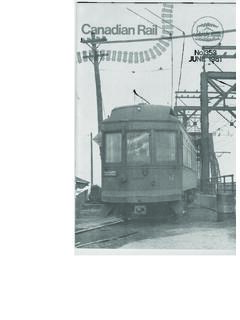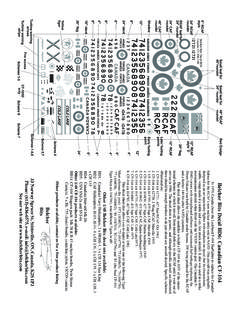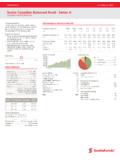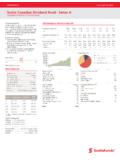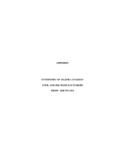Transcription of Canadian Rail no247 1972 - Exporail
1 1938 197e t~~~pn;'~8:;Y 1 9"7'2 -: .. ; I , , , , , ., I \ , \ 1 t . ~ot Out io P8~tur8 )'ot I From information and pictures supplied by Abitibi Paper Company Limited. $ he's had many names, this "iron horse", but just as in the case of a married woman, it's the last one that counts! Number 70 is the name of the Abitibi Paper Company's Shay steam locomotive at the Company's newsprint mill in Iroquois Falls, Ontario. For those who are interested -and who isn't? -Iroquois Falls is at the end of Highway 67, off the Trans-Canada Highway, some 80 miles north of North Bay, Ontario. Yes, you can drive there, but it is more sporting to take the Ontario Northland Railway~ Once or twice every couple of years, 70 is steamed up and taken out of her stall, pressed into service while the diesel-electric unit is in the shop for an # No doubt if Number 70 could talk, she would have one or two remarks to make about the way they build diesel-electric units today.
2 "They don't make them new-fangled machines like us old-timers!" "Oldtimers"? Little does Number 70 know that she is pro-bably the last working steam locomotive of this vintage in Canada. Well, almost the last. Nowadays, Number 70's part-time job consists of shunting cars around the Company's railway yard. Gone are the exciting days on the tricky, uneven right-of-way, opening up new logging areas and hauling carloads of pulpwood to the hungry paper mill. Those were the days, my friends! Number 70's story began on February 27, 1926, when, as a class "c" Shay - a development of Ephriam's original patent -she was outshopped by the Lima Locomotive Works of Lima, Ohio. Her three 12x15-inch cylinders and 36-inch drivers gave her a pulling power that was hard to beat. Number 70 was ordered by the Tallassee Power Company of Calderwood,Tennessee, Her builder's number was 3298 and Tallassee Power gave her road number 9. Number 70's southern sojourn was terminated ~Ihen she went to the ALCOA Power Company at Shipshaw,Quebec, probably to assist in the construction of the giant power dam.
3 She "laS still numbered 9. In December, 1930, she was sold OTTAWA BRANCH PRESIDENT DUNCAN DUFRESNE SUPPLIED THE PICTURE FOR THIS month's cover. In the days of steam, Canadian Pacific Railway's G-3 4-6-2 Number 2455 starts Train 40 from Montreal West,Quebec, on an afternoon in February, 1948. ~ Number 70 of the Abitibi Paper Company, Iroquois Falls, Ontario -on the page opposite -operates only once or twice every couple of years, shunting cars in the Company's yard. But when she's needed, she's really needed. Canadian 236 R A I L to the Dominion Construction Company of Cochrane, Ontario, where she was renumbered 3298 (her construction number) and remained for some 11 years. In April, 1941, Number 70 -alias Number 3298 -was purcha-sed by the Standard Chemical Company of South River, Ontario. Fina1-I~ 1y, the IC"_c1ass Shay was purchased by the Abitibi Power and Paper Company -later Abitibi Paper Company -for the operation in and around Iroquois Falls, Ontario, One look at Number 70 will convince you that she is built not for speed, but for pO'ller and versatility.
4 Once, she could make 18 miles per hour, if she were hard-pressed. But Number 70's real talent was hauling logging trains over ungraded tracl,-, with tight curves, humps and sags. She was also versatile in switching long, heavy trains of newsprint in the Company's yards and spotting empties in short sidings with tight curves. Her talents were most useful in mill switching after 1955, when the Company terminated railway operation in the .. lOods and began bringing out the wood by truck. Retirement may not be a happy thought for some. But Number 70 doesn't have to face this situation just yet. Despite the fact that spare parts are almost impossible to obtain -most remaining plans and blueprints, would you believe, are now in the Smithsonian Institution,1>Jashington, "U, -she is kept in good condition, Her crew and their associates, needless to say, help to keep Number 70 running with lots of tender, loving care, That's why, when any job around th,e yard need doing, Number 70 is ready and willing to tackle the job.
5 This isn't the end of Number 70's story. It's just another episode in a history of useful service. Hel1-lmown today, you may be sure that when the time comes for Number 70 to be turned out to pas-ture, there will be plenty of people who will remember her valuable contribution and will provide the care and attention which her dis-tinguished career has earned. GONE, ALAS, ARE THE DAYS OF THE LOGGING train that opened up new lumbering areas and hauled the logs and pulpwood to the hungry mill. Luckily, someone had the foresight to take a picture! Even today, there are times when Number 70 handles conSiderable tonnage in mak-ing up trains in the Abitibi Paper Com-pany's yard at Iroquois Falls, Ontario. I ".: ' . ~ -. --. ' .. ~ -." .. "" .. c Canadian 238 R A I L Vital Statistics. Type: Class C Shay BIN 3298 Date built: February 27,1926 70-ton, three-truck Gauge: 4 feet 8~ inches Cyls.: 3, 12x1511 Drivers: 3611 Engine & Tender wheelbase: 40 feet 2 inches Rigid wheelbase: 29 feet 8 inches.
6 Factor of adhesion: in working order: 170,000 lbs. Tractive effort: 30,350 lbs. Boiler: Extended wagon-top : 200 psig Tubes: 97 x 211, 11 feet long. 15 x 5 3/811 x il feet long. Total heating surface: 888 Total length over dral'lbars: 53 feet. Grate area: sq. ft. Maximum height: 14 feet 8 inches. Water: 1300 gals. Number 70 will operate 3-4 hours on 1300 gallons of water and 10-12 hours on a capacity load of coal, under normal conditions. She can operate on 35-lb. rail and can negotiate a curve of 75 ' radius. , AT THE TOP OF THE HILL EASTBOUND: Canadian NATIONAL RAILlJAYS STATION ~ at Port Union, Ontario. This was usually the eastern limit of opera-tion for the "Brutes". The back-track behind the station is visible at the extreme right and left. Photo courtesy Edward Emery.. c,~ .. FIB" .. Edward Emery and Edward Helmich . he main line of the Grand Trunk Railway Company of Canada which approaches Toronto Union Sta-tion from the east has, since its construction, suffered from one major drawback.
7 This is the gradient eastward from Union Station, out of the Don River valley up to Scarborough and Port Union on the table-land a-bove Lake Ontario. Because of the comparatively level stretches on this plateau, the main freight classification yard for tonnage arriving from the east was established almost at the beginning at Danforth. West of Toronto, the Great Western Railway was the original line to London and Windsor or Sarnia. Freight trains from this direction generally terminated at Minico, miles west of Toronto Union Station. After the amalgamation of the Grand Trunk with several other railway companies to form the Canadian National Railway Company, all coming from the east continued to be handled at Danforth Yard, while trains arriving from the west were classified at Mimico Yard, Loads for the city of Toronto,or from one yard to the other , were handled in "transfer" freights, which had either to climb or to descend the hill between Don Station and Danforth.
8 To provide the motive power required to move these sometime he~ vy freights, the Canadian Locomotive Company, Kingston, OntariO, re-ceived an order from Canadian National in 1924 for the largest and most powerful steam locomotives ever to operate in Canada. Although they were subsequently surpassed in weight by the famous "Selkirks" of the Canadian Pacific, they continued to be the most powerful lo-comotives in Canada and in the Commonwealth. Having road numbers 4100-4104, these mammoth 2-l0-2s were classed by the CN as T-2-a and were rated at 80%-B, the "B" being the booster on the trailing truck. Canadian NATIONAL RAILWAYS CLASS T-2-A, NUMBER 4103 -BUILT BY THE Canadian Locomotive Company of Kingston, Ontario -pictured at the Christie Street Roundhouse in July, 1952. Photo courtesy HK Vollrath. Number 4100 of the same class was photographed by Harold K. Vollrath at Montre'al, Quebec, in July, 1956. Number 4100 was built by Kingston in 1924.
9 \ \ ! CNR CLASS T-2-A, NUMBER 4102, BUILT BY Canadian LOCOMOTIVE COMPANY IN ~ 1924, photographed by Harold ~. Vollrath at Montreal, Quebec in July, 1935. After about 10 years of service in this transfer work, the need for the "Brutes" disappeared when Danfor"th Yard was closed, due in part to the financial recession and decreased business of the 1930s. All the Danforth facilities were transferred to Mimico. When Danforth closed, the 4100s were displaced from transfer service. However, the freights eastbound from Mimico still needed assistance up the long grade to Scarborough and Port Union. Obviously, the lUOOs were most suitable for assisting or "helper" service and thus the locomotives gained a new lease on life. The "Brutes" -as they were affectionately called by the engine crews -were also frequently required on CN's Helland and Dunnville Subdivisions, to haul freight trains up the Niagara Escarpment to Welland, Port Colborne and Fort Erie.
10 The regularly assigned power was either CN Number 3457 or 3480, both 2-8-2s. If one of these mi-kados was out of service for repairs, a 4100-class 2-10-2 was sent from Mimico as a temporary replacement. On trips east out of Mimico, the 4100s generally ran pilot for-ward, in the normal manner, helping freight trains up to Port Union. There, they would uncouple and run through the crossover to the west-bound main line, taking water before depa!' for Mimico, if nec-essary. If there ~las considerable traffic on the westbound main, they would take the "hole" thich was a siding that ran behind Port Union station -to wait for a westbound freight to which they would be cou-pled for the return trip. But, wonder of wonders, they would run in the train for only the ll-mile trip to Don station, "There they would uncouple and run light back to Mimico. Many times, they would not wait at Port Union for a westbound freight, but would run light back to Toronto.
